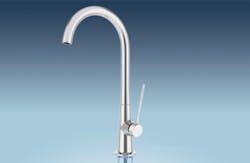A recent study by USA Today showed that in a quarter of U.S. locations water prices have doubled, and sometimes tripled, over the last 12 years. As the cost of water, energy to heat it and to manage it and associated sewage costs continue to rise, it is more important than ever that we look for ways to make plumbing products and practices more efficient.
A good way to start
Many cities are offering free or low-cost showerheads and aerators, and that’s certainly a good way to start educating the public about water consumption. True conservation, though, must come from manufacturers, engineers, contractors and plumbers who are committed to water-saving products and procedures, and from end users vigilant in monitoring leaks and inefficiency.
Here is an example of the impact even one small change can have: In a facility where 40 hand washings per day are happening — at 30 seconds per hand washing, repeated 365 days — if an owner/operator switched out a faucet’s standard 2.2 gpm faucet aerator to a low-flow 0.5 gpm aerator, that facility could save more than 12,000 gallons of water per year. That’s a 77 percent savings. And, saving 12,000 gallons of water has a direct correlation to energy and sewage savings as well.
A single leaky faucet, dripping at the rate of one drip per second, can waste more than 3,000 gallons of water per year. That is pure waste, and it happens in schools, homes, hospitals, stores and office buildings around the country because most of us make the incorrect assumption that fixing a leak is a time-consuming pain in the neck. But, that is not true. Faucet leaks happen in one of three places: The spout, the handle or the base. If it is the spout, chances are the O-ring, seat washer or, less often, the seat, needs replacing. If it is the handle, worn packing or a worn gasket needs to be replaced. Base leaks usually mean a worn-out O-ring or coupling gasket.
Look at faucet design and manufacturing
Faucet design and construction has changed significantly in recent years. Through improved technology, manufacturers have been able to simplify installation methods on many faucets, resulting in lower installation costs. Material construction has also experienced a vast change over the last five years. California’s low-lead initiative (AB1953) governing the lead content in faucets to a weighted average of no more than 0.25 percent drastically changed the materials and manufacturing of faucets. That initiative, signed into effect by President Obama on January 4, 2011, became the “Reduction of Lead in Drinking Water Act,” also known as Senate Bill 3874, which became a national law requiring full compliance on January 4, 2014.
The outcome of all this evolution is that newer faucets do not leak nearly as often as older ones do. Washerless valve technologies have virtually put an end to unwanted drips and, by doing away with handles, sensor faucets have eliminated one more legendary leak source.
Should you yank out every old faucet you come across? Well, if it’s been in place more than 50 years, you might give it some thought. That’s about as long as you can expect brass to remain at peak performance and decorative features, such as porcelain handles, become fragile with age and are subject to cracks and breakage. If an old faucet is working fine, though, there is no particular reason to replace it, especially if you can install a low-flow aerator to give it some conservation quality.
That being said, there are plenty of reasons you might want to upgrade to a contemporary faucet. Electronic sensor faucets, besides offering sleek styling and significant water savings, offer hygiene benefits and, in above-deck models, extra easy repairs. They are also a more user-friendly choice for facilities serving those who have difficulty maneuvering traditional faucet handles. While early versions of sensor faucets earned a reputation for less-than-stellar performance, the newest iterations deliver reliable infrared operation as well as convenient, high-tech features such as automatic time-outs and shut-off delays, adjustable temperature control mixing valves and low battery/troubleshooting LED indicator lights.
If faucet replacement is not the direction you want to go, there are plenty of water savings to be had simply through replacing standard compression cartridges with ceramic ones. Ceramic cartridges are precision polished to create a watertight seal that simply will not leak. Most users see about a 20 percent reduction in water usage, as well as a reduction in maintenance costs, after the ceramic cartridges are installed.
Water is finally, if slowly, being acknowledged as the precious, limited resource it has always been. Any reduction in usage is a step forward, whether that is through repairing or preventing leaks, building facilities with WaterSense approved products or retrofitting existing facilities with accessories, such as ultra low-flow aerators, spray valves and showerheads and high efficiency washing machines and toilets. The tools and products are out there. Now, it is up to each of us individually to use water wisely, responsibly and effectively.
Richard Fahey is senior marketing product manager for T&S Brass and Bronze Works. With an MBA from Clemson University and a B.S. in Engineering from Louisiana State, he directs all new product development and oversees global product line management.
